| | Introduction
When you visit a grocery store you may see meat and food products labelled as “Halal”.
What does that mean?
So.....What is "Halal"?
Halal is an Arabic term that means permitted or lawful in Islam. It is both an umbrella term used in relationship to all food products, and a term that refers to a method of livestock slaughter consistent with Islamic rites.1
In Canada, Halal food sales exceeded $1 billion in 2017 and that will likely continue to grow rapidly. This rise isn't simply due to an increase in the Muslim population in Canada. Curious millennials are exploring food options, including Halal. Gourmets with a keen interest in food have also converted to Halal foods.2
Kosher vs. Halal
Kosher food has been a staple in grocery stores for many years. Like Halal food, kosher food stems from religious principles and translates to acceptable. Kosher food products have been used as substitutes for Halal and are likely the only accepted product to substitute for Halal for some consumers.3 Table 1 summarizes some of the key attributes of the Halal and kosher food systems.
Table 1: Kosher and Halal Attributes
Kosher and Halal Attributes
|
| | Kosher | Halal |
| Definition | Acceptable | Arabic word meaning lawful or permitted |
| Origin | Religious — Bible and Talmud | Religious — Quran |
| Food and food products not permitted | Pigs, rabbits, shellfish, insects | Pork and its by-products, animals with fangs, blood and blood by-products. Halal animals improperly slaughtered, lard, alcohol and foods contaminated with the aforementioned. |
| Mix-up and cross-contamination | Milk and meat products must not be mixed. Cheese, wine, grape juice must be prepared either in whole or in part by Jewish people. | Not concerned with mixing up and cross-contamination of dairy and meat products. |
| Who Performs Animal Slaughter | Only a devout Jewish person. | A mature Muslim that fully understands the Islamic procedure and conditions of animal slaughter. While it is not regarded as ideal, Muslims are permitted to eat meat slaughtered by people of other Abrahamic faiths, meaning religious Jews and Christians. |
| Certification | Many different certifiers globally. | Many different certifiers globally. |
Source: Halal and Kosher market study on export opportunities for the Canadian and US markets, conclusions and recommendations - Volume 1 Manitoba Agriculture, Food and Rural Initiatives, Province of Manitoba
Population Trends and Domestic Market Opportunity
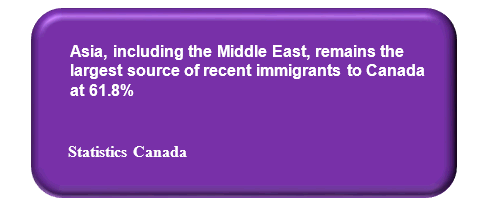
The percentage of new immigrants living in Alberta reached 17.1 per cent in 2016 compared with 6.9 per cent in 2001.4
As illustrated in Figure 1, Asia, including the Middle East, remains the largest source of recent immigration to Canada at 61.8 per cent. Syria was the seventh most important source of immigrants due to the influx of refugees and was previously ranked 50th in 2011.5
Figure 1: Country of Origin of Recent Canadian Immigrants
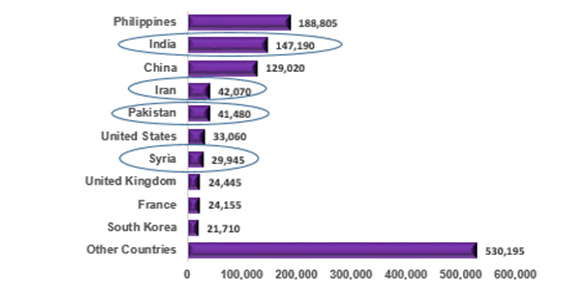
Source: Statistics Canada
According to Statistics Canada, Canada’s Arab population nearly doubled in the past decade to 523,235. As illustrated in Figure 2, the greatest growth of the Arab population in the last decade occurred in Lethbridge which experienced a 757 per cent increase. In the past 15 years, immigration to the prairies has doubled with Alberta as the strongest magnet. "Due to economic factors, immigrants are looking for jobs," explains René Houle, a senior analyst at Statistics Canada. "We know in Alberta, in Saskatchewan, the economy is growing, it's strong."6
Figure 2: Arab Population Group Growth by Census Metropolitan Area – Per cent, 2006 vs 2016
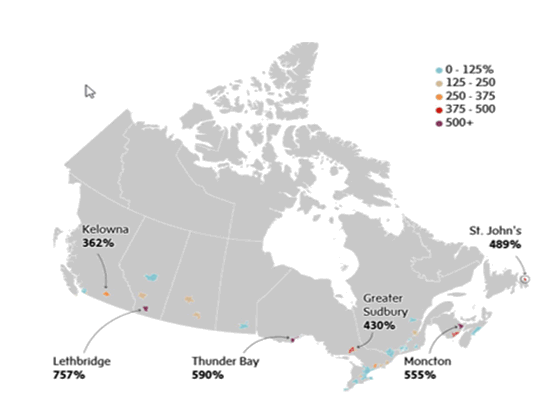
Source: Globe and Mail
This substantial population growth will serve to fuel increased demand for Halal meat as many recent immigrants favour Halal meat due to religious reasons. In addition, there are consumers who eat Halal meat for non-religious reasons which contributes toward increasing demand. As a result, the distribution of Halal foods has expanded beyond traditional markets.
Halal Food Market Forecast and International Market Opportunity
Market Forecast
The potential value of the global Halal food market is being discussed by media and market researchers globally with many providing forecasts regarding what they deem to be the market value. While there is no universally agreed upon market value, what is unanimous is that the Halal food market will grow significantly in the upcoming years. Forecasts for the Halal food market range from CAD$80 billion to US$2.5 trillion. Following below are various forecasts on the potential value of the Halal food market.

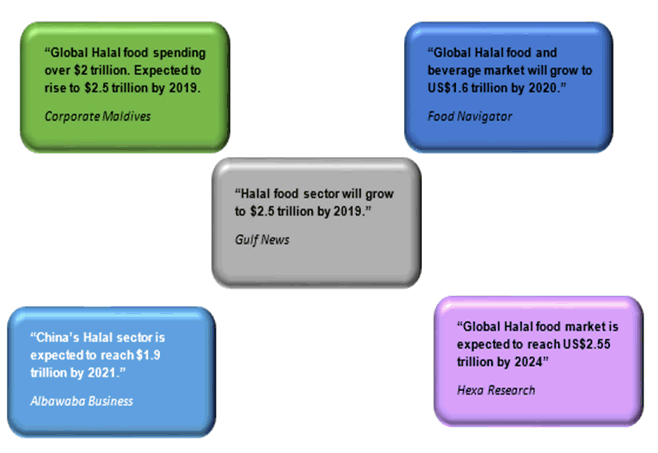
International Market Opportunity
While there is great market opportunity for Halal meat in Alberta, the international market also poses tremendous opportunity. The growing global Muslim population and increasing per capita meat consumption spur demand in this market.7
Per Capita Meat Consumption - Illustrated in Figure 3 are countries that offer the greatest market opportunity for Halal meat exports as well as their 2016 per capita meat consumption. The United Arab Emirates comprises the greatest per capita meat consumption of the regions listed below. Following in second place is Malaysia which is only slightly greater than third place Saudi Arabia. China has a small Muslim population and pork comprises the largest proportion of per capita meat consumption. Poultry is the most highly consumed meat per capita among all of the countries below, with the exception of China. Per capita beef and poultry consumption are nearly equal in Egypt..
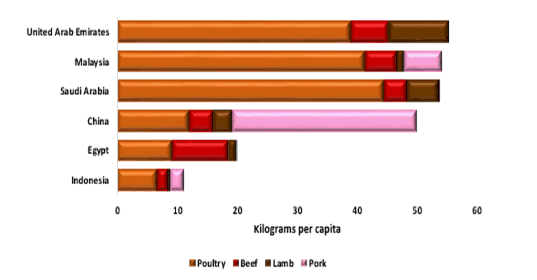
Source: OECD Meat Consumption
Note: Meat consumption is measured in thousand tonnes of carcass weight (except for poultry expressed as ready to cook weight) and in kilograms of retail weight per capita. Carcass weight to retail weight conversion factors are: 0.7 for beef and veal, 0.78 for pig meat, and 0.88 for both
International markets that offer the greatest Halal meat market opportunities are import dependent. The per capita meat consumption in some of these regions is growing more rapidly than the production capacity. Meat imports in Halal meat consuming markets such as the United Arab Emirates, Saudi Arabia, Indonesia, Malaysia, and China are significantly rising in response.
What Does this Mean?
As the population from countries where Halal meat is widely consumed continues to rise, and as consumers eat Halal meat for non-religious reasons, the demand for Halal meat will increase in response. This presents opportunities for Alberta producers, processors, and exporters to capitalize on this lucrative market.

1 Halal certification in Australia: a quick guide, 30 August 2016, Parliament of Australia, Parliamentary Library, Research Paper Series, 2016-17
2 Sylvain Charlebois, Dean of the Faculty of Management, Dalhousie University, February 8, 2017
3 Imarat Consultants, An Overview of the Global Halal Market
4 Ibid.
5 Ibid.
6 Globe and Mail
7 Food Navigator, September 17, 2017
Sources:
- CBC News, Key highlights from latest release of 2016 census data, October 25, 2017,
- Charlebois, Sylvain, Dean of the Faculty of Management, Dalhousie University
- Food Navigator, September 17, 2017
- Globe and Mail
- Halal and Kosher market study export opportunities for the Canadian and US Markets conclusions and recommendations – Volume 1 Manitoba Agriculture, Food and Rural Initiatives, Province of Manitoba
- Imarat Consultants, An Overview of the Global Halal Market
- OECD Meat Consumption
- Statistics Canada
|
|